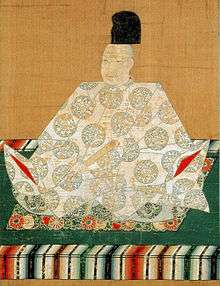Emperor Ōgimachi
| Ōgimachi | |
|---|---|
| Emperor of Japan | |
 Ōgimachi | |
| Reign | 1557–1586 |
| Predecessor | Go-Nara |
| Successor | Go-Yōzei |
| Born | June 18, 1517 |
| Died | February 6, 1593 (aged 75) |
| Burial | Fukakusa no kita no Misasagi (Kyoto) |
Emperor Ōgimachi (正親町天皇 Ōgimachi-tennō) (June 18, 1517 – February 6, 1593) was the 106th Emperor of Japan, according to the traditional order of succession. He reigned from October 27, 1557, to December 17, 1586, corresponding to the transition between the Warring States Era and the Azuchi–Momoyama period. His personal name was Michihito (方仁).[1]
Genealogy
Ōgimachi was the first son of Emperor Go-Nara
- _________?
- Eldest son: Imperial Prince Masahito (誠仁親王 Masahito-shinnō, 1552–1586), also known as Prince Sanehito and posthumously named Yōkwōin daijō-tennō. Masahito's eldest son was Imperial Prince Kazuhito (和仁親王 Kazuhito-shinnō, 1572–1617) who became Emperor Go-Yōzei.[2] Go-Yōzei elevated the rank of his father, even though his father's untimely death made this impossible in life. In this manner, Go-Yōzei himself could enjoy the polite fiction of being the son of an emperor.
- Lady-in-waiting: Madenokōji (Fujiwara) Fusako (万里小路(藤原)房子)
- Second daughter: Princess Eikō (永高女王)
- Fifth son: Imperial Prince Sanehito (誠仁親王)
Events of Ōgimachi's life
Ōgimachi became Emperor upon the death of Emperor Go-Nara.
- 1560 (Eiroku 3, 1st month): Ōgimachi was proclaimed emperor. The ceremonies of coronation were made possible because they were paid for by Mōri Motonari and others.[3]
- 1560 (Eiroku 3, 5th month): Imagawa Yoshimoto led the armies of the province of Suruga against the Owari; and at the Battle of Okehazama, his forces fought against Oda Nobunaga; but Imagawa's army was vanquished and he was slain. Then Nobunaga took over the province of Owari. Tokugawa Ieyasu took over the province of Mikawa and made himself master of Okazaki Castle.[1]
- 1564 (Eiroku 7): Oda Nobunaga completed the conquest of Mino; and he built a new castle at Gifu.[4]
- 1568 (Eiroku 11, 2nd month): Ashikaga Yoshihide became shogun.[5]
- 1568 (Eiroku 11, 9th month): Shogun Yoshihide died from a contagious disease.[5]
The finances of the emperor and his court were greatly strained. The authority of the Imperial Court also began to fall, but this trend reversed after Oda Nobunaga entered Kyoto in a show of allegiance but which also indicated that the Emperor had the Oda clan's support. Frequently using the Emperor as a mediator when fighting enemies, Nobunaga worked to unify the disparate elements to Japan. However, by around 1573, Nobunaga began demanding the Emperor's abdication, but the Emperor refused.
Before political power was transferred to Toyotomi Hideyoshi, in order to take advantage of Ōgimachi's authority, the power of the Imperial Family was increased. In this way, Hideyoshi and the Imperial Family entered into a mutually beneficial relationship.
In 1586, Emperor Ōgimachi abdicated in favor of his grandson, Imperial Prince Katahito (周仁親王), who became the Emperor Go-Yōzei.[6] Ōgimachi retired to the Sennōda Palace. On February 6, 1593, he died.
During Ōgimachi's reign, with the assistance of Oda Nobunaga and Toyotomi Hideyoshi, the imperial family was able to halt the political, financial, and cultural decline it had been in since the Ōnin War, and began a time of recovery.
Ōgimachi is enshrined with other emperors at the imperial tomb called Fukakusa no kita no misasagi (深草北陵) in Fushimi-ku, Kyoto.[7]
Kugyō
Kugyō (公卿) is a collective term for the very few most powerful men attached to the court of the Emperor of Japan in pre-Meiji eras. Even during those years in which the court's actual influence outside the palace walls was minimal, the hierarchic organization persisted.
In general, this elite group included only three to four men at a time. These were hereditary courtiers whose experience and background would have brought them to the pinnacle of a life's career. During Ōgimachi's reign, this apex of the Daijō-kan included:
- Daijō-daijin, Konoe Sakihisa, 1536–1612.[8]
- Sadaijin
- Udaijin
- Naidaijin
- Dainagon
Eras of Ōgimachi's reign
The years of Ōgimachi's reign are more specifically identified by more than one era name or nengō.[1]
See also
Notes

- 1 2 3 Titsingh, I. (1834). Annales des empereurs du Japon, p. 383.
- ↑ Ponsonby-Fane, Imperial House, p. 424; this Imperial Prince was enshrined in Tsukinowa no misasagi at Sennyū-ji.
- ↑ Titsingh, p. 383; Varley, H. Paul. (1980). Jinnō Shōtōki, p. 44; n.b., a distinct act of senso is unrecognized prior to Emperor Tenji; and all sovereigns except Jitō, Yōzei, Go-Toba, and Fushimi have senso and sokui in the same year until the reign of Emperor Go-Murakami.
- ↑ Titsingh, P. 385.
- 1 2 Titsingh, p. 386.
- ↑ Following Ōgimachi, no other emperor remained on the throne past the age of 40 until 1817, when Emperor Kōkaku abdicated at age 47.
- ↑ Ponsonby-Fane, Richard. (1959). The Imperial House of Japan, p. 423.
- ↑ Citation based on 近衛前久, retrieved from the Japanese Wikipedia on July 14, 2007.
References
- Ponsonby-Fane, Richard Arthur Brabazon. (1959). The Imperial House of Japan. Kyoto: Ponsonby Memorial Society. OCLC 194887
- Titsingh, Isaac, ed. (1834). [Siyun-sai Rin-siyo/Hayashi Gahō, 1652], Nipon o daï itsi ran; ou, Annales des empereurs du Japon. Paris: Oriental Translation Fund of Great Britain and Ireland.
- Varley, H. Paul, ed. (1980). [ Kitabatake Chikafusa, 1359], Jinnō Shōtōki (A Chronicle of Gods and Sovereigns: Jinnō Shōtōki. New York: Columbia University Press. ISBN 0-231-04940-4
| Regnal titles | ||
|---|---|---|
| Preceded by Emperor Go-Nara |
Emperor of Japan: Ōgimachi 1557–1586 |
Succeeded by Emperor Go-Yōzei |
